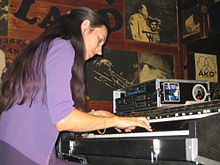Barbara Dennerlein
Barbara Dennerlein | |
|---|---|
Electronic organ, synthesizer, organ | |
| Years active | 1980s–present |
| Website | barbaradennerlein |
Barbara Dennerlein (born 25 September 1964 in Munich)
Career

Early years
Dennerlein was born and grew up in
Recordings
When her third
Instruments
Dennerlein modified a Hammond's pedalboard to trigger
After a variety of projects and after playing with unconventional musicians, such as
Compositions
Dennerlein claims to have been primarily influenced by jazz and was not initially interested in classical or church music, although it was and is popular in Germany.[4] She has never been enthusiastic about formal music theory, preferring to learn things through improvisation.[9] However, she has further said that her main influence from jazz is the ability to mix other musical styles as desired, saying "To me, jazz is a synonym for freedom. Freedom from prejudice and discrimination".[8]
Dennerlein's first album included four of her own pieces. Her
Awards
- 1995: "German Record Critics Award" ("Preis der deutschen Schallplattenkritik") for "Take Off"
- 1995: "Jazz Award" for "Take Off" for holding the number one position in the German Jazz Charts for several months and for being best selling Jazz Album of the year in Germany
- 1987: "German Record Critics Award" ("Preis der deutschen Schallplattenkritik") for "Tribute to Charlie".
Discography
- 1983: Jazz Live
- 1984: Orgelspiele
- 1985: Bebab
- 1986: Days of Wine and Roses
- 1987: Tribute to Charlie
- 1988: Barbara Dennerlein Plays Classics
- 1989: Straight Ahead!
- 1989: Live on Tour!
- 1990: Hot Stuff and Barbara Dennerlein Duo (Bootleg)
- 1991: (Friedrich Gulda) Mozart No End
- 1992: That's Me and Solo
- 1995: Take Off!
- 1997: Junkanoo
- 1999: Outhipped
- 2001: Love Letters
- 2002: Spiritual Movement No.1 (church organ recording)
- 2004: In a Silent Mood
- 2005: It's Magic
- 2006: The Best of Barbara Dennerlein
- 2007: Change of Pace (with Philharmonic Orchestra under Bernd Ruf)
- 2008: Spiritual Movement No. 2 (live at Kaiser William Memorial Church in Berlin)
- 2010: Bebabaloo
- 2012: Spiritual Movement No. 3 (live 2008 concert on the Rieger organ at the Stadtpfarrkirche in Fehring, Austria, with guitarist Edi Köhldorfer)
- 2015: Studiokonzert (live concert in recording studio, direct to two-track analogue tape)
- 2015: Christmas Soul
References
- ^ a b c d e Yanow, Scott. "Barbara Dennerlein". allmusic. Retrieved 20 December 2009.
- ^ ISBN 0-87930-308-5.
- ^ a b Enstice & Stockhouse 2004, p. 98.
- ^ a b Enstice & Stockhouse 2004, p. 100.
- ^ a b "Barbara Dennerlein". All About Jazz. Archived from the original on 18 January 2009. Retrieved 20 December 2009.
- ^ Enstice & Stockhouse 2004, p. 108.
- ^ a b Enstice & Stockhouse 2004, p. 97.
- ^ a b "Barbara Dennerlein (organ) – Jazz Meets Pipe Organ – Spiritual Movements". Berliner Philharmoniker. 4 November 2012. Archived from the original on 15 October 2012.
- ^ Enstice & Stockhouse 2004, p. 101.
- ^ a b Doerschuk, Robert L. (May 1991). "Jazz organ like you've never heard it". Keyboard. 17 (#181): 28–38.
- ^ Enstice & Stockhouse 2004, pp. 104–105.
Cited sources
- Enstice, Wayne; Stockhouse, Janis (2004). Jazzwomen: Conversations with Twenty-one Musicians, Volume 1. Indiana University Press. ISBN 9780253344366.
